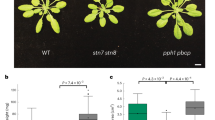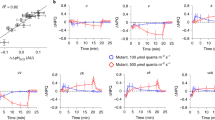Abstract
This work tested the hypothesis that thylakoid localized proton-binding domains, suggested to be involved in localized\(\Delta \tilde \mu _{H^ + } \)-driven ATP formation, are maintained with the involvement of several membrane proteins, including the LHCII (Laszlo, J. A., Baker, G. M., and Dilley, R. A. (1984) Biochim. Biophys. Acta 764, 160–169), which comprises about 50% of the total thylakoid protein. The concept we have in mind is that several membrane proteins cooperate to shield a localized proton diffusion pathway from direct contact with the lumen, thus providing a physical barrier to H+ equilibration between the sequestered domains and the lumen. A barely mutant,chlorina f 2, that lacks Chl b and does not accumulate some of the LHCII proteins, was tested for its capacity to carry out localized-proton gradient-dependent ATP formation. Two previously developed assays permit clear discrimination between localized and delocalized\(\Delta \tilde \mu _{H^ + } \) gradient-driven ATP formation. Those assays include the effect of a permeable buffer, pyridine, on the number of single-turnover flashes needed to reach the energetic threshold for ATP formation and the more recently developed assay for lumen pH using 8-hydroxy-1,3,6-pyrene trisulfonic acid as a lumenally loaded pH-sensitive fluorescent probe. By those two criteria, the wild-type barley thylakoids revealed either a localized or a delocalized energy coupling mode under low- or high-salt storage conditions, respectively. Addition of Ca++ to the high-salt storage medium caused those thylakoids to maintain a localized energy-coupling response, as previously observed for pea thylakoids. In contrast, thechlorina f 2 mutant thylakoids had an active delocalized energy coupling activity but did not show localized\(\Delta \tilde \mu _{H^ + } \) energy coupling under any conditions, and added Ca++ to the thylakoid storage medium did not alter the delocalized energy coupling mode. One interpretation of the results is that the absence of the LHCII polypeptides produces a “leaky” pathway for protons which allows the\(\Delta \tilde \mu _{H^ + } \) gradient to equilibrate with the lumen under all conditions. Another interpretation is possible but seems less likely, that being that the absence of the LHCII polypeptides in some way causes the proposed Ca++ -gated H+ flux site on the membrane sector (CF0) of the energy coupling complex to lose its gating function.
Similar content being viewed by others
References
Allnutt, F. C. T., Atta-Asafo-Adjei, E., and Dilley, R. A. (1989).J. Bioenerg. Biomembr. 21, 535–551.
Baker, G., Bhatnagar, D., and Dilley, R. A. (1981).Biochemistry 20, 2307–2315.
Beard, W. A., and Dilley, R. A. (1988).J. Bioenerg. Biomembr. 20, 129–154.
Boardman, N. K., and Highkin, H. R. (1966).Biochim. Biophys. Acta 126, 189–199.
Burke, J. J., Steinback, K. E., and Arntzen, C. J. (1979).Plant Physiol. 63, 237–243.
Chiang, G., and Dilley, R. A. (1987).Biochemistry,26, 4911–4916.
Chiang, G., Wooten, D., and Dilley, R. A. (1992).Biochemistry 31, 5808–5819.
Davis, D. J., and Gross, E. L. (1975).Biochim. Biophys. Acta 387, 557–567.
Dilley, R. A. (1991).Curr. Top. Bioenerg. 16, 265–318.
Dilley, R. A., Theg, S. M., and Beard, W. A. (1987).Annu. Rev. Plant Physiol. 38, 347–389.
Goodchild, D. J., Highkin, H. R., and Boardman, N. K. (1966).Exp. Cell Res. 43, 684–688.
Graan, T., Flores, S., and Ort, D. R. (1981). InEnergy Coupling in Photosynthesis (Selman, B. R., and Selman-Reimer, S., eds.),Developments in Biochemistry, Vol. 20, Elsevier North-Holland, New York, pp. 25–34.
Gutman, M., and Nachliel, E. (1990).Biochim. Biophys. Acta 1015, 391–414.
Hangarter, R. P., Jones, R. W., Ort, D. R., and Whitmarsh, J. (1987).Biochim. Biophys. Acta 890, 106–115.
Horner, R. D., and Moudrianakis, E. N. (1986).J. Biol. Chem. 261, 13408–13414.
Izawa, S., and Pan R. L. (1978).Biochem. Biophys. Res. Commun. 83, 1171–1177.
Jahns, P., and Junge, W. (1990).Eur. J. Biochem. 193, 731–736.
Jahns, P., Polle, A., and Junge, W. (1988).EMBO J. 7, 589–594.
Johnson, J. D., Pfister, V. R., and Homann, P. H. (1983).Biochim. Biophys. Acta 723, 256–265.
Karlin-Neumann, G. A., Kohorn, B. D., Thornber, J. P., and Tobin, E. M. (1985).J. Mol. Appl. Genet. 3, 45–61.
Kühlbrandt, W., and Wang, D. N. (1991).Nature (London)350, 130–134.
Laasch, H. (1992).Z. Naturforsch. 47c, 717–725.
Laszlo, J. A., Baker, G. M., and Dilley, R. A. (1984).Biochim. Biophys. Acta 764, 160–169.
Machold, O., Simpson, D. J., and Møller, B. L. (1979).Carlsberg Res. Commun. 44, 235–254.
Nagle, J. F., and Dilley, R. A. (1986).J. Bioenerg. Biomembr. 18, 55–64.
Ouijja, A., Farineau, N., Cantrel, C., and Guillot-Salomon, T. (1988).Biochim. Biophys. Acta 932, 97–106.
Peter, G. F., and Thornber, J. P. (1991).J. Biol. Chem. 266, 16745–16754.
Pfister, V. R., and Homann, P. H. (1986).Arch. Biochem. Biophys. 246, 525–530.
Pfündel, E. E., and Dilley, R. A. (1993).Plant Physiol.,101, 65–71.
Pick, U., Weiss, M., and Rottenberg, H. (1987).Biochemistry 26, 8295–8302.
Prochaska, L. J., and Dilley, R. A. (1978).Arch. Biochem. Biophys. 187, 61–71.
Prochaska, L. J., and Gross, E. L. (1977).J. Membr. Biol. 36, 13–32.
Renganathan, M., Pfündel, E. E., and Dilley, R. A. (1993).Biochim. Biophys. Acta 1142, 277–292.
Ruban, A. V., Walters, R. G., and Horton, P. (1992).FEBS Lett. 309, 175–179.
Ryie, I. J. (1983).Eur. J. Biochem. 131, 149–155.
Sigalat, C., Haraux, F., de Kouchkovsky, F., Hung, S. P. N., and de Kouchkovsky, Y. (1985).Biochim. Biophys. Acta 809, 403–413.
Simpson, D. J. (1979).Carlsberg Res. Commun. 44, 305–336.
Staehelin, L. A., and Arntzen, C. J. (1983).J. Cell Biol. 97, 1327–1337.
Tandy, N., Bhatnagar, D., Hermodson, M. A., and Dilley, R. A. (1982).J. Biol. Chem. 257, 4301–4307.
Theg, S. M., Johnson, J. D., and Homann, P. H. (1982).FEBS Lett. 145, 25–29.
Theg, S. M., Chiang, G. G., and Dilley, R. A. (1988).J. Biol. Chem. 263, 673–681.
White, M. J., and Green, B. R. (1988).Photosynth. Res. 15, 195–203.
Author information
Authors and Affiliations
Rights and permissions
About this article
Cite this article
Renganathan, M., Dilley, R.A. Evidence that the intrinsic membrance protein LHCII in thylakoids is necessary for maintaining localized\(\Delta \tilde \mu _{H^ + } \) energy coupling. J Bioenerg Biomembr 26, 117–125 (1994). https://doi.org/10.1007/BF00763223
Received:
Accepted:
Issue Date:
DOI: https://doi.org/10.1007/BF00763223




